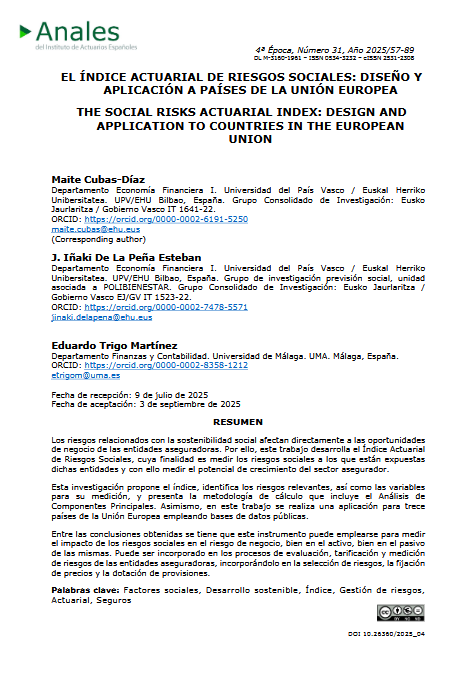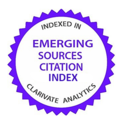El índice actuarial de riesgos sociales: diseño y aplicación a países de la Unión Europea
DOI:
https://doi.org/10.26360/2025_04Palabras clave:
Factores sociales, Desarrollo sostenible, Índice, Gestión de riesgos, Actuarial, SegurosResumen
Los riesgos relacionados con la sostenibilidad social afectan directamente a las oportunidades de negocio de las entidades aseguradoras. Por ello, este trabajo desarrolla el Índice Actuarial de Riesgos Sociales, cuya finalidad es medir los riesgos sociales a los que están expuestas dichas entidades y con ello medir el potencial de crecimiento del sector asegurador.
Esta investigación propone el índice, identifica los riesgos relevantes así como las variables para su medición, y presenta la metodología de cálculo que incluye el Análisis de Componentes Principales. Asimismo, en este trabajo se realiza una aplicación para trece países de la Unión Europea empleando bases de datos públicas.
Entre las conclusiones obtenidas se tiene que este instrumento puede emplearse para medir el impacto de los riesgos sociales en el riesgo de negocio, bien en el activo, bien en el pasivo de las mismas. Puede ser incorporado en los procesos de evaluación, tarificación y medición de riesgos de las entidades aseguradoras, incorporándolo en la selección de riesgos, la fijación de precios y la dotación de provisiones.
Descargas
Citas
Australian Actuaries Climate Index (2018). Australian Actuaries Climate Index: Design Documentation. Actuaries Institute. Consultado el 18 de agosto de 2024, desde https://actuaries.logicaldoc.cloud/download-ticket?ticketId=52034b4d-5c50-4bff-b4d7-05e084d2fc42
Actuaries Climate Index (2018). Actuaries Climate Index: Development and Design. American Academy of Actuaries, Canadian Institute of Actuaries, Casualty Actuarial Society, y Society of Actuaries. Consultado el 18 de agosto de 2024, desde https://actuariesclimateindex.org/wp-content/uploads/2019/05/ACI.DevDes.2.20.pdf
Antolin, P., Payet, S., y Yermo, J. (2012). Coverage of Private Pension Systems. Working Papers on Finance, Insurance and Private Pensions, No. 20, OECD Publishing, Paris, https://doi.org/10.1787/5k94d6gh2w6c-en.
Blustein, D. L., Olle, C., Connors-Kellgren, A., y Diamonti, A. J. (2016). Decent Work: A Psychological Perspective. Frontiers in Psychology, 7. https://doi.org/10.3389/fpsyg.2016.00407
Bundesanstalt für Finanzdienstleistungsaufsicht. (2020). Guidance notice on dealing with sustainability risks. Bundesanstalt für Finanzdienstleistungsaufsicht. Consultado el 14 de junio de 2024, desde https://www.bafin.de/SharedDocs/Downloads/EN/Merkblatt/dl_mb_Nachhaltigkeitsrisiken_en.pdf?__blob=publicationFile&v=5
Cubas-Díaz, M., y Martinez Sedano, M. A. (2018). Measures for sustainable investment decisions and business strategy–a triple bottom line approach. Business Strategy and the Environment, 27 (1), 16-38. https://doi.org/10.1002/bse.1980.
Curry, C. (2015). Extension of the Actuaries Climate Index to the UK and Europe. A Feasibility Study. Institute and Faculty of Actuaries. https://www.actuaries.org.uk/system/files/field/document/UK_ACI_scoping_FINAL.pdf
Deutsche Gesellschaft für Internationale Zusammenarbeit. (2017). Inclusive insurance and the Sustainable Development Goals - how insurance contributes to the 2030 Agenda for Sustainable Development. Deutsche Gesellschaft für Internationale Zusammenarbeit. Consultado el 14 de junio de 2024, desde https://microinsurancecentre.milliman.com/en/Insight/inclusive-insurance-and-the-sustainable-development-goals-how-insurance-contributes-to-the-2030-agen
Dias‐Sardinha, I., & Reijnders, L. (2005). Evaluating environmental and social performance of large Portuguese companies: a balanced scorecard approach. Business Strategy and the Environment, 14(2), 73-91. https://doi.org/10.1002/bse.421
Directiva 2009/138/CE del Parlamento Europeo y del Consejo, de 25 de noviembre de 2009, sobre el seguro de vida, el acceso a la actividad de seguro y de reaseguro y su ejercicio (Solvencia II). (DO L, núm. 335, 17.12.2009, pp.1155). Consultado el 2 de julio de 2024, desde https://eur-lex.europa.eu/legal-content/ES/LSU/?uri=CELEX:32009L0138
Directiva 2022/2041 del Parlamento Europeo y del Consejo, de 19 de octubre de 2022, sobre unos salarios mínimos adecuados en la Unión Europea. (DO L, núm.275, 25.10.2022, pp.33-47). Consultado el 29 de noviembre de 2024, desde https://eur-lex.europa.eu/legal-content/ES/TXT/PDF/?uri=CELEX:32022L2041
Dyreborg, J., Lipscomb, H. J., Nielsen, K., Törner, M., Rasmussen, K., Frydendall, K. B., Bay, H., Gensby, U., Bengtsen, E., Guldenmund, F. y Kines, P. (2022). Safety interventions for the prevention of accidents at work: A systematic review. Campbell Systematic Reviews, 18(2), e1234. https://doi.org/10.1002/cl2.1234
European Insurance and Occupational Pensions Authority. (2015). Guidelines on Own Risk Solvency Assessment (ORSA). Consultado el 12 de junio de 2025, desde https://www.eiopa.europa.eu/publications/guidelines-own-risk-solvency-assessment-orsa_en
Fabrigar, L. R., & Wegener, D. T. (2012). Exploratory factor analysis. Oxford University Press.
Garrido, J., Milhaud, X., y Olympio, A. (2023). The definition of a French actuarial climate index; one more step towards a European index. Consultado el 20 de mayo de 2024, desde https://www.researchgate.net/publication/376982040_The_definition_of_a_French_actuarial_climate_index_one_more_step_towards_a_European_index
Gatzert, N., Reichel, P., y Zitzmann, A. (2020). Sustainability risks & opportunities in the insurance industry. Zeitschrift für die gesamte Versicherungswissenschaft, 109, 311-331. https://link.springer.com/article/10.1007/s12297-020-00482-w
GNH Centre Bhutan. (2024). Gross National Happiness. Consultado el 15 de julio de 2024, desde https://www.gnhcentrebhutan.org/
Gorsuch, R. L. (1983). Factor analysis (2ª ed.). Lawrence Erlbaum.
Hagenaars, J. A., & McCutcheon, A. L. (Eds.). (2002). Applied latent class analysis. Cambridge University Press. https://doi.org/10.1017/CBO9780511499531
Helliwell, J. F., Layard, R., Sachs, J. D., De Neve, J.-E., Aknin, L. B., y Wang, S. (Eds.). (2024). World Happiness Report 2024. University of Oxford: Wellbeing Research Centre. Consultado el 28 de septiembre de 2024, desde https://worldhappiness.report/ed/2024/
Hotelling, H. (1933). Analysis of a complex of statistical variables into principal components. Journal of Educational Psychology, 24(6), 417. https://doi.org/10.1037/h0071325
Hoyle, R. H. (Ed.). (2012). Handbook of structural equation modeling. Guilford Press.
International Labour Organization. (2008). Declaration on Social Justice for a Fair Globalization. International Labor Organization. Consultado el 28 de noviembre de 2024, desde https://www.ilo.org/sites/default/files/wcmsp5/groups/public/%40ed_norm/%40declaration/documents/genericdocument/wcms_371208.pdf
Iniciativa Financiera del Programa de las Naciones Unidas para el Medio Ambiente. (2012). PSI Principios para la Sostenibilidad en Seguros. Naciones Unidas. Consultado el 7 de abril de 2025, desde https://www.unepfi.org/psi/wp-content/uploads/2013/06/PSI-document_Spanish.pdf
Jackson, J. E. (2005). A user’s guide to principal components. John Wiley & Sons. https://onlinelibrary.wiley.com/doi/book/10.1002/0471725331
Jofre-Bonet, M. (2000). Public health care and private insurance demand: the waiting time as a link. Health Care Management Science, 3, 51-71. https://link.springer.com/article/10.1023/A:1019024903898
Jolliffe, I. T. (2002). Principal component analysis for special types of data. Springer. https://link.springer.com/content/pdf/10.1007/0-387-22440-8_13.pdf
Jolliffe, I. T., y Cadima, J. (2016). Principal component analysis: a review and recent developments. Philosophical Trans. R. Soc. A., 374:20150202. http://doi.org/10.1098/rsta.2015.0202
Kaiser, H. F., y Rice, J. (1974). Little Jiffy, Mark IV. Educational and Psychological Measurement, 34(1), 111-117. https://doi.org/10.1177/001316447403400115
Kjosevski, J. (2012). The determinants of life insurance demand in central and southeastern Europe. International Journal of Economics and Finance, 4(3), 237-247. http://dx.doi.org/10.5539/ijef.v4n3p237
Kline, R. B. (2016). Principles and practice of structural equation modeling (4ª ed.). Guilford Press
Kochenburger, P. (2014). Liability insurance and gun violence. Conn. L. Rev., 46 (4), 1265. Consultado el 29 de noviembre de 2024, desde https://heinonline.org/HOL/LandingPage?handle=hein.journals/conlr46&div=36&id=&page=
Kupiainen, S., Hautamäki, J., y Karjalainen, T. (2009). The Finnish education system and PISA. Opetus- ja kulttuuriministeriö. Consultado el 29 de noviembre de 2024, desde https://julkaisut.valtioneuvosto.fi/bitstream/handle/10024/75640/opm46.pdf
Le Roux, B., y Rouanet, H. (2010). Multiple correspondence analysis. SAGE Publications.
Legatum Institute. (2024). The Legatum Prosperity Index™. Consultado el 15 de julio de 2024, desde https://index.prosperity.com/
Melyn W. y Moesen W.W. (1991), Towards a synthetic indicator of macroeconomic performance: unequal weighting when limited information is available, Public Economic research Paper 17, CES, KU Leuven.
Morgan, H. (2014). Review of research: The education system in Finland: A success story other countries can emulate. Childhood Education, 90(6), 453-457. https://doi.org/10.1080/00094056.2014.983013
Naciones Unidas. (2024). Objetivos de Desarrollo Sostenible. Consultado el 14 de agosto de 2024, desde https://www.un.org/sustainabledevelopment/es/objetivos-de-desarrollo-sostenible/
Nogueira, F. G., Lucena, A. F., y Nogueira, R. (2018). Sustainable insurance assessment: Towards an integrative model. The Geneva Papers on Risk and Insurance-Issues and Practice, 43, 275-299. https://doi.org/10.1057/s41288-017-0062-3
Organización para la Cooperación y el Desarrollo Económicos y Centro Común de Investigación de la Comisión Europea. (2008). Handbook on constructing composite indicators: Methodology and user guide (OECD Statistics Working Paper Series). OECD Publishing. https://doi.org/10.1787/9789264043466-en
Organización para la Cooperación y el Desarrollo Económicos. (2024). Tu Índice para una Vida Mejor. Consultado el 15 de julio de 2024, desde https://www.oecdbetterlifeindex.org/es/about/better-life-initiative/
Pearson, K. (1901). LIII. On lines and planes of closest fit to systems of points in space. The London, Edinburgh, and Dublin philosophical magazine and journal of science, 2(11), 559-572. https://doi.org/10.1080/14786440109462720
Petrova, E. (2015). Road and railway transport in Russia: safety and risks. Advances in Environmental Sciences, 7 (2), 259-271.
Platform on Sustainable Finance. (2022). Final Report on Social Taxonomy. European Union. Consultado el 7 de mayo de 2025, desde https://finance.ec.europa.eu/document/download/494fa7fe-5dea-4c57-bda5-59c1e3a0db49_en?filename=220228-sustainable-finance-platform-finance-report-social-taxonomy_en.pdf
Porter, M. E., Stern, S., y Artavia Loría, R. (2013). Social Progress Index 2013. Social Progress Imperative Washington, DC.
Programa de las Naciones Unidas para el Desarrollo. (2024). Human Development Index (HDI). Consultado el 14 de julio de 2024 desde https://hdr.undp.org/data-center/human-development-index#/indicies/HDI
Reglamento Delegado (UE) 2023/2772 de la Comisión, de 31 de julio de 2023, por el que se completa la Directiva 2013/34/UE del Parlamento Europeo y del Consejo en lo que respecta a las normas de presentación de información sobre sostenibilidad. (DOUE, nº 2772, 22 de diciembre de 2023, pp.1-284). Consultado el 15 de mayo de 2024, desde https://eur-lex.europa.eu/legal-content/en/TXT/?uri=CELEX:32023R2772
Rejda, G. E., y McNamara, M. J. (2021). Principles of risk management and insurance (14ª ed.). Pearson.
Saaty, T. L. (1980). The Analytic Hierarchy Process. McGraw Hill.
Sandström, A. (2016). Handbook of solvency for actuaries and risk managers: theory and practice. CRC press.
Schiller, F. (2024). Social sustainability in the insurance industry: A crucial component. The European Actuary, 40, 13-14. Consultado el 7 de mayo de 2025, desde https://actuary.eu/wp-content/uploads/2024/11/TEA-40-DEC-1.pdf
Scordis, N. A., Suzawa, Y., Zwick, A., y Ruckner, L. (2014). Principles for sustainable insurance: Risk management and value. Risk Management and Insurance Review, 17 (2), 265-276. https://doi.org/10.1111/rmir.12024
Snedecor, G., y Cochran, W. (Eds.). (1989). Statistical Methods (8ª edición). Iowa State University Press.
Social Progress Imperative. (2024). Global Social Progress Index. Consultado el 28 de septiembre de2024, desde https://www.socialprogress.org/social-progress-index
Stern, S., Harmacek, J., Krylova, P., y Htitich, M. (2024). 2024 Social Progress Index Methodology Summary. Social Progress Imperative Washington, DC. Consultado el 17 de agosto de 2024, desde https://tinyurl.com/5akvt3ax
The Legatum Institute Foundation. (2023). The 2023 Legatum Prosperity Index-Overview. Consultado el 28 de septiembre de 2024, desde https://docs.prosperity.com/7116/7757/0247/The_2023_Legatum_Prosperity_Overview_report.pdf
Usman, T., Fu, L., y Miranda-Moreno, L. F. (2010). Quantifying safety benefit of winter road maintenance: Accident frequency modeling. Accident Analysis & Prevention, 42(6), 1878-1887. https://doi.org/10.1016/j.aap.2010.05.008
Vaughan, E. J., y Vaughan, T. M. (2013). Fundamentals of Risk and Insurance (11ª ed.). Wiley.
Wals, A. E., y Schwarzin, L. (2012). Fostering organizational sustainability through dialogic interaction. The Learning Organization, 19(1), 11-27. https://doi.org/10.1108/09696471211190338
World Population Review. (2024). Human Development Index (HDI) by Country 2024. Consultado el 29 de septiembre de 2024, desde https://worldpopulationreview.com/country-rankings/hdi-by-country
Yao, C., Parker, J., Arrowsmith, J., y Carr, S. C. (2017). The living wage as an income range for decent work and life. Employee relations, 39(6), 875-887. https://doi.org/10.1108/ER-03-2017-0071
Ying, X.-H., Hu, T.-W., Ren, J., Chen, W., Xu, K., y Huang, J.-H. (2007). Demand for private health insurance in Chinese urban areas. Health economics, 16(10), 1041-1050. https://doi.org/10.1002/hec.1206
Ziegler, A., Schröder, M., y Rennings, K. (2007). The effect of environmental and social performance on the stock performance of European corporations. Environmental and resource Economics, 37, 661-680. https://link.springer.com/article/10.1007/s10640-007-9082-y
Zhou, N., Vilar-Zanón, J. L., Garrido, J., y Martínez, A.-J. H. (2023). On the definition of an actuarial climate index for the Iberian Peninsula. Anales del Instituto de Actuarios Españoles, 4(29), 37-59. https://doi.org/10.26360/2023_3

Publicado
Cómo citar
Número
Sección
Licencia
Derechos de autor 2025 Maite Cubas-Díaz, J. Iñaki De la Peña Esteban, Eduardo Trigo Martínez

Esta obra está bajo una licencia internacional Creative Commons Atribución-NoComercial-SinDerivadas 4.0.

















